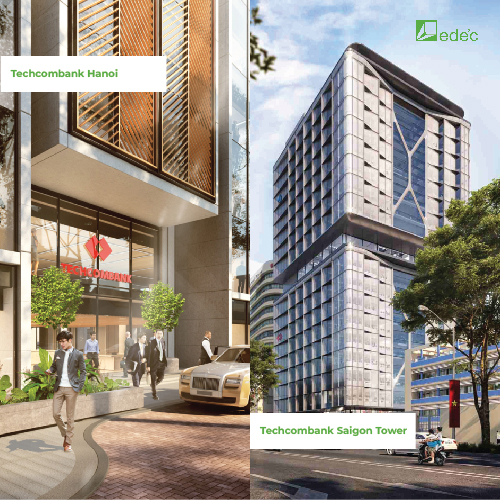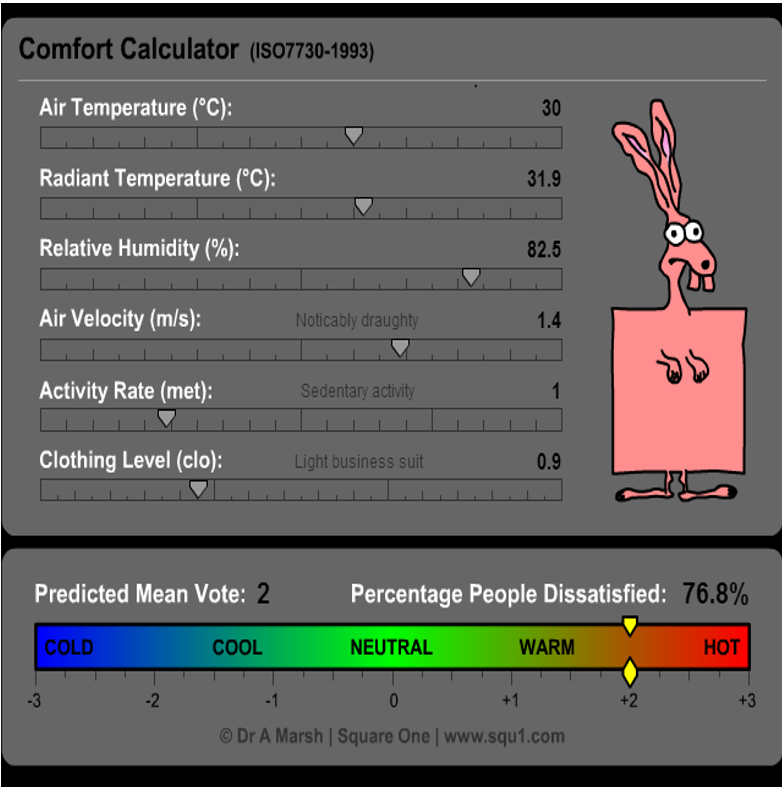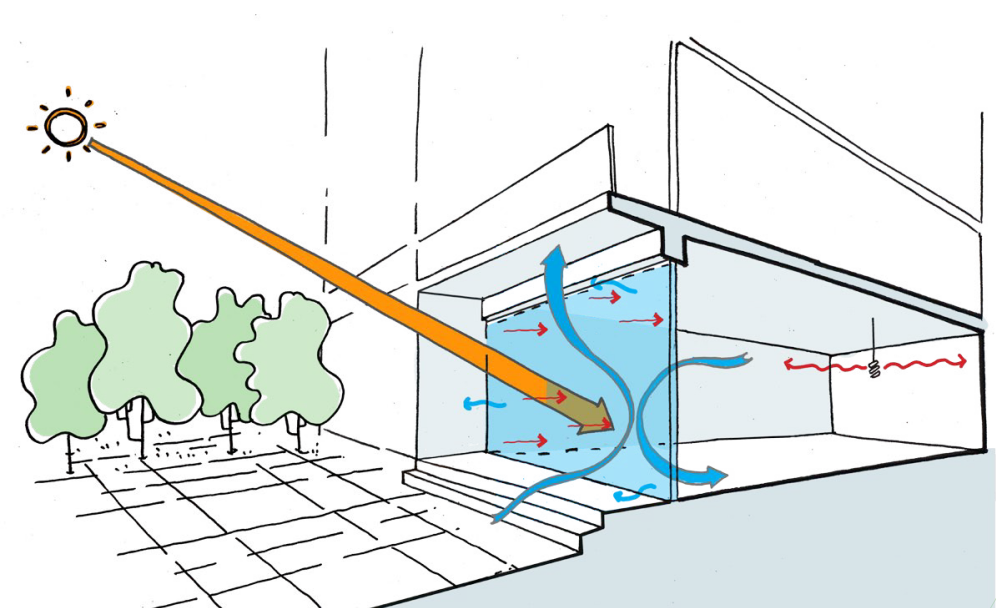RESOURCES
The Villa Hoi An – The first green hotel HQE (France) in Vietnam

The Villa Hoi An with the full name Charming Hoi An Villas (Hoi An Charming Tourist Villas Cluster) has become the first project to achieve the HQE Green Building certificate (France) in Vietnam – the “difficulty” certificate. most” now after being officially recognized on June 22, 2018.
How does The Villa Hoi An register as the “most difficult” project in the Green Building market? How is the process of pursuing HQE certification for the project team?

Pictures of The Villa Hoi An project – The first HQE Green Building in Vietnam
What is HQE Green Building Certificate (France)?

Haute Qualité Environnementale (abbreviated as HQE) is a voluntary certificate originating from France, very popular in Europe and several countries in South America such as Brazil,… HQE certification and operating organization – Cerway has been developing the organization and strategy for this certificate since 2002, but it has been around since the mid-1990s.
HQE certification conducts an assessment of the entire life cycle of a building including design, construction, renovation, and operation. Non-residential buildings, apartment buildings, detached houses as well as urban planning and development are all eligible for HQE certification.
Why is HQE considered the most “difficult” Green Building Certificate today?
With more than 20 years of establishment and development, HQE is considered by Green Building Consultant Tran Thanh Vu (EDEEC) as the most prestigious but at the same time “strictest” certification in the market today.
Firstly, HQE has the highest number of criteria (compared to LEED and LOTUS – 2 other popular certificates in Vietnam) with 14 criteria. Completing well and meeting all 14 criteria in the HQE certificate is a complicated task.
Second, the process of inspecting and evaluating an HQE-certified project is rigorous. It is recognized as the world’s highest level of inspection and supervision according to ISO ratings.
Mr. Tran Thanh Vu said: “The expert appointed by Cerway will participate in strict design control with the project management team and design team, and also give the advice to adjust the design accordingly. match the desired level of the certificate. When the project is completed, experts will directly visit and inspect the work locally in the presence of relevant units participating in the project. This is one of the reasons why HQE is considered the “most difficult” Certificate in the market.”
HQE-certified projects in Vietnam
As of December 2020, the number of certified green buildings in Vietnam has only stopped at 155 works, of which there are rare 2 projects that have achieved HQE Green Building Certificate (France), namely The Villa Hoi. An and Yersin Alexandre French School.
This number directly shows the “fastidiousness” of HQE and not any project can easily receive certification from Cerway.

Yersin Alexandre French School – Green building achieved a rare HQE certificate in Vietnam with The Villa Hoi An
The process of pursuing HQE requires support from a consulting unit with a technical core, especially a technical core on Building Energy Saving and cost optimization through the application of Energy Simulation (standards). Energy factor accounts for the highest score in the HQE certification system) to ensure adherence to the set goals while minimizing costs for the Investor.
The Villa Hoi An – The first HQE Green Building (France) in Vietnam
The Villa Hoi An project information
The Villa Hoi An project is located at 89 – 91 Cua Dai Street, Hoi An, Quang Nam with a total floor area of 2339 m2. The project has a scale of 60 rooms, including 6 clusters of 3-story villas (on the Cua Dai street side) and 4 floors (rear) with a maximum number of floors of 4. The project is renovated and aims to achieve certification. only HQE (France).

Pictures of The Villa Hoi An Resort – Hotel
Result
The Villa Hoi An project excellently achieved the HQE PASS certificate with the advice and support implemented by EDEEC.
EDEEC conducted an Energy Efficiency & Cost Analysis of the project through the application of the Building Energy Simulation technique and obtained the following results:
- REDUCES 315 MILLION operating costs/per year
- Reduce energy consumption by 45%/year

HQE Green Building The Villa Hoi An campus
With a total floor area of only 2339 m2, the Investor The Villa Hoi An was able to CUT 315 million VND in operating costs while still ensuring the highest living comfort and economical and efficient use of energy. thanks to eco-design ideas, climate adaptation, and Energy Simulation applications. This is the work that should be prioritized from the very beginning for any project when setting goals to pursue Green Building certification.

HQE Green Building Certificate granted to The Villa Hoi An hotel and resort

Project image on HQE official website
Read more: Benefits of Building Energy Simulation right from the design stage
Architectural solutions in Green Building HQE The Villa Hoi An
Winding corridor

Located in a favorable position for tourism development, with a high density of trees and water surface, The Villa Hoi An is designed to be distributed in a distributed manner, linked together by a system of green corridors surrounding each block. The house feels like the small lanes of the village in Hoi An. The organization of traffic spaces as green corridors creates exchanges and interactions between individuals in the community and is a highlight of the local cultural “sticky community”.


The winding corridor creates a unique landscape for the building, helping to make the most of natural ventilation
Distributed cube combination
The complex of scattered cubes provides lots of cool shade, and creates many narrow spaces, with the idea of village roads and alleys, creating local ventilation for the project as well as not obstructing the airflow to the rear areas. In addition, the blocks create many shadows on each other to create the best sunshade effect for the building.

The complex of dispersed blocks helps to increase the efficiency of shading and ventilation for the building. A system of wooden slats to shade the sun during the day and a place to “hang lanterns” at night
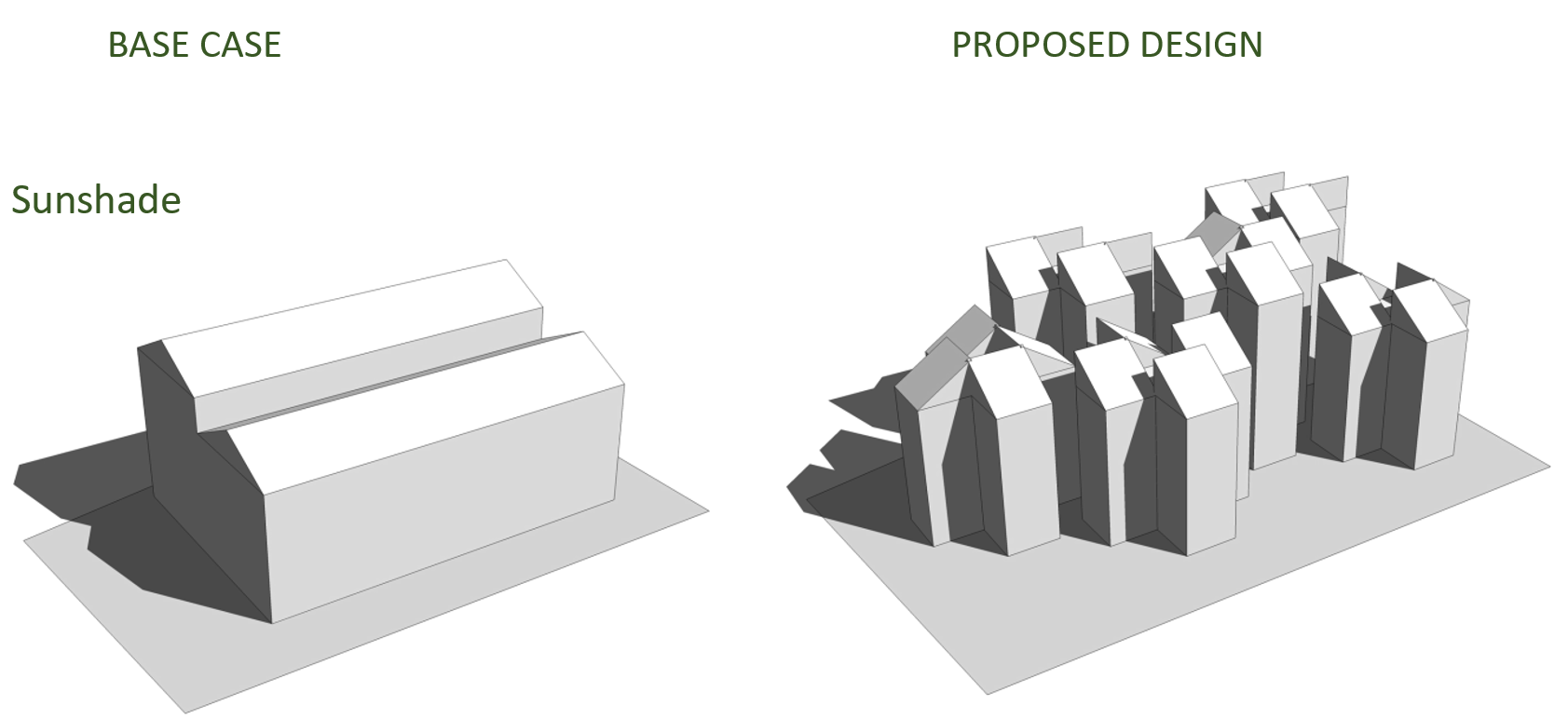

Simulation image of the sun’s shadow and heat radiation of the 2 design options of the building block. The proposed scheme (dispersion block combination) provides a better shading effect. (Image provided by EDEEC)

This is a breakthrough design in Hoi An because the original plan for this area only allowed it to be encapsulated in 2 shapes, one is individual villas, dispersed with internal traffic, and the other is a large block with a corridor between.
The architectural design unit has gone through about 20 formal meetings and a lot of side-convincing, the current solution has just been approved and proven to be effective in land use and the great creativity of the architects. plan for the total area as above.

The resort rooms at The Villa Hoi An still have windows in different areas to create ventilation
Greening the building
Along with the urban development, the development from the Village to the Street, the density of trees is decreasing day by day, it is necessary to restore the green area for the urban area with each project.
To restore the green area for the area, the design team collaborated with EDEEC to advise on greening the project with a total planting area of 1993m2 trees/1550m2 of land.
The density of trees in the building is large with green roofs and green corridors bringing harmony with the landscape. The roof surface is covered with green from locally grown plants, is very livable, and requires no special care.

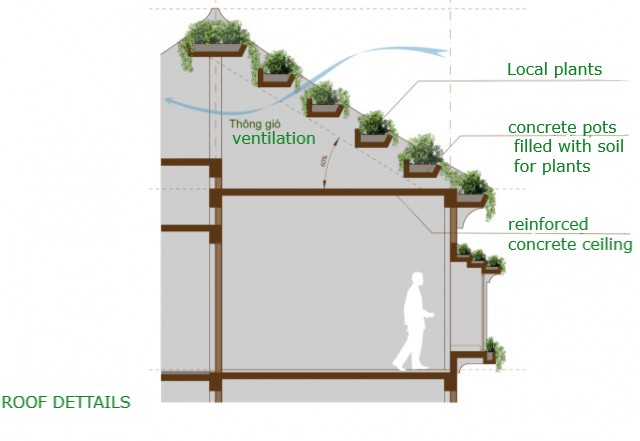
The density of trees in the building is large with green roofs and green corridors bringing harmony with the landscape
The main wall surfaces of the building are also covered with a layer of wooden spokes, which both cover the sun and have a decorative effect, concealing the lights at night, and creating a feeling like countless lanterns are lit. up in the old town of Hoi An.
It can be seen that with 3 core architectural solutions to make the most of the building’s ability to shading, natural ventilation, and cooling, this design has helped the building reduce the use of electrical equipment. cooling, and ventilation, thereby effectively saving energy for the building in addition to related technical solutions.
Before this project, green roof projects in Hoi An had never been licensed for construction due to fears of disrupting the ancient landscape with red tile roofs of the city. When the project is completed, Hoi An city has accepted to allow the implementation of green roofs easily with future projects.
This is a highly appreciated point when EDEEC was invited to participate in the project report at the International Green Building Conference in Paris at the end of 2017. The most appreciated content was that the project had a mind-changing impact. government (construction managers) on climate adaptation and sustainable development solutions

The density of trees in the building is large with green roofs and green corridors bringing harmony with the landscape. Public spaces are also very transformative and creative.


Guests can relax with a book and enjoy the view here

Solutions for social harmony, respecting local residents
Only one photo is below but hidden in it are the thoughts and concerns of the designer who is always towards sustainability for both the environment and society. Underneath the lawn is a type of brick with a gap that allows grass to grow and water to seep underneath so that rainwater can seep into the ground, minimizing groundwater depletion.
Also on this land, if the Investor and the architect do not think carefully about the surrounding residents, they can expand the work to 2/3 of this lawn by the plan.
But no, the work is back to create space and vision for the shrine, and at the same time, the investor provides financial support for people to embellish their temples. Residents here have also become more friendly and appreciative of hotel owners and architects than ever before. Their concerns when forming the project disappeared, and people’s beliefs were respected and maintained as part of the local culture.

HQE Green Building – The Villa Hoi An with a design that is always towards sustainability for both the environment and society
Tourists are also very interested when participating in religious and cultural activities right where they have minutes to enjoy the modern but full of identity, as well as when they get acquainted with friendly people and nature. the peace of Hoi An.
Technical Solutions in Green Building HQE – The Villa Hoi An
Using high-quality sound and heat insulation materials
Materials are one of the important factors in projects pursuing Green Building certification. Recycled materials, materials with low emission, materials of natural origin, and local materials… are good materials for the environment and are encouraged to use.
The Villa Hoi An project also prioritizes the use of industrial ecological materials with high-quality sound and heat insulation advantages such as 3D panels, autoclaved concrete bricks, … or furniture. from recycled wood, and pressed bamboo panels.

These materials are both quick and convenient to be constructed, suitable for Vietnam’s climatic conditions and at the same time reduce labor costs for the investor. In addition, the construction process is entirely carried out by local workers, to train newcomers and improve the skills of existing workers.
Use of solar energy
Solar energy is a clean energy source, contributing to reducing emissions and generating energy for operations. Therefore, EDEEC has decided to advise on the use of solar energy for The Villa Hoi An project to serve the hot water heating system and exterior lights with a moderate area to ensure compliance with energy criteria. and HQE waste.
Use high-efficiency air conditioners
Saving energy in ecological projects such as Green Building contributes to environmental protection and saves operating costs for the project. The equipment consulted for The Villa Hoi An project must also meet standards, have energy labels, and ensure star performance such as inverter VRF (inverter) air conditioning systems.

In particular, the rooms have instructions and an outdoor temperature indicator device so that users can open the door, make the most of the wind and save energy, which creates a connection between the users. and local natural climate.
If you follow the instructions correctly, each person can help reduce 1kg of CO2 emissions into the environment every day, increasing the individual’s social responsibility. This is also a highly appreciated point at the International Green Building Conference in Paris in 2017, closely following 17 sustainable development goals.

Save, collect & reuse water
Saving and using water efficiently is an important condition of a Green Building. EDEEC has offered solutions to use and save water following the architecture and functions of the project such as:
- Rainwater collection and reuse: The collected rainwater is put into storage tanks and used for watering plants, misting cooling, and sanitary equipment;
- Drip irrigation: scientific irrigation, installation, and operation are simpler than other traditional irrigation systems, bringing economic efficiency, and saving labor, material, and electricity costs for water pumping.
The winding balconies are all planted with plants and use an automatic drip irrigation system, which ensures the very efficient use of water. Water for irrigation is also used to the fullest extent from the rainwater collection tank to optimize the use of water resources and improve user awareness about the use of this resource.

The layout of the cooling rainwater misting system in The Villa Hoi An project

Conclude
The HQE certificate holder highly appreciates The Villa Hoi An project for bringing a new highlight and changing the local government’s concept of sustainable construction management.
Moreover, thanks to the “Right design, right construction, and right operation”, ensuring optimal ventilation and having a green roof with vegetation above the building, The Villa Hoi An project achieves a completely worthy result. worthy of the title of “The first HQE Green Building Certificate project in Vietnam” with the in-depth and experienced advice of the EDEEC Team of Experts.
Tran Thanh Vu – Green Building Consultant, Founder of EDEEC


